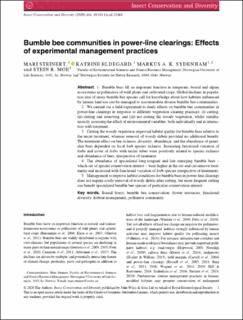| dc.description.abstract | 1. Bumble bees fill an important function in temperate, boreal and alpineecosystems as pollinators of wild plants and cultivated crops. Global declines in popula-tion size of many bumble bee species call for knowledge about how habitats inuencedby human land use can be managed to accommodate diverse bumble bee communities.2. We carried out a field experiment to study effects on bumble bee communities inpower-line clearings in response to different vegetation clearing practices: (i) cutting,(ii) cutting and removing, and (iii) not cutting the woody vegetation, whilst simulta-neously assessing the effect of environmental variables, both individually and in interac-tion with treatment.3. Cutting the woody vegetation improved habitat quality for bumble bees relative tothe uncut treatment, whereas removal of woody debris provided no additional benet.The treatment effect on bee richness, diversity, abundance, and the abundance of gener-alist bees depended on local forb species richness. Increasing functional variation offorbs and cover of forbs with nectar tubes were positiv ely related to species richnessand abundance of bees, irrespective of treatment.4. The abundance of specialized long-tongued and late emerging bumble bees –which are of special conservation interest – were higher in the cut and cut-remove treat-ments and increased with functional variation of forb species irrespective of treatments.5. Management to improve habitat conditions for bumble bees in power-line clearingsdoes not require costly removal of woody debris after cutting, but more frequent cuttingcan benefit specialized bumble bee species of particular conservation interest.Key words. Boreal forest, bumble bee conservation, flower resources, functionaldiversity, habitat management, pollinator community | en_US |

